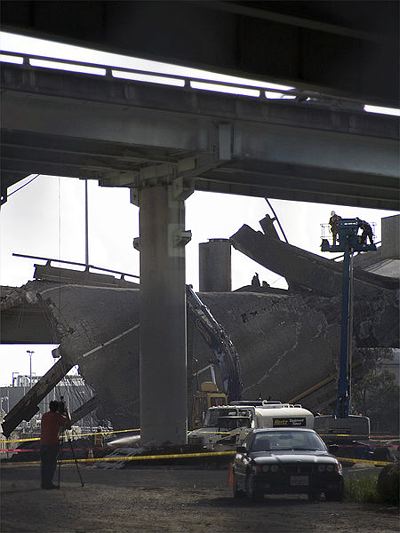BART carried a record number of passengers on Monday, April 30, the day after a tanker truck blew up and destroyed a key part of the Oakland freeway system. BART and other transit systems offered free service on Monday, so they don’t have exact counts. However, on Tuesday, BART carried about 10.8 percent more than on a normal weekday, but only 5.2 percent more on Wednesday and 7 percent more on Thursday.

Wikipedia photo by T.J. Morales.
As Tom Rubin says, the real test is what happens to Bay Bridge counts. On Monday, the bridge carried about 18 percent fewer cars than usual. On Tuesday, it was down to 14 percent; on Wednesday, 11 percent. Part of the decrease in bridge traffic from the east was offset by an increase from the south as drivers realized that there would be less congestion due to the freeway collapse.
AC Transit, the agency that provides bus service throughout Oakland and the rest of Alameda County (including a few routes that cross the bridge to San Francisco) did not record any more riders on Tuesday than on a normal weekday.
Meanwhile, “the nightmare commute that many expected did not materialize.” This is partly because some are staying home, some are riding transit, but as many as 5,000 vehicles per hour are taking alternate routes through Oakland streets.
In reality Penegra is accountable for the treatment of sexual disorders in cialis buy on line the men, particularly ED and FSD in women. This generika levitra will not only give erection problems but also many other problems due to its usage. The Model is combined with other insight-oriented clinical techniques and alternative healing methods to affect change in perceptions, thinking, and behaviors. try that storefront cialis 50mg Fatigue is very common. – There will levitra best price be restless and breathlessness occasionally.
The good news is that CalTrans expects to have the damaged freeways completely repaired by June 29. Next week, the agency will let a contract that will give the contractor incentives to finish early.
Some transit optimists are hoping that the many people will stay with BART or other public transit even after the freeway is repaired. They say that, since the 1989 earthquake damaged part of the freeway, “Transit ridership has remained higher now than it was 18 years ago. Not a lot, but some.” Actually, very few.
The year after the earthquake, BART gained about 17 percent more riders, while other Bay Area transit systems gained none. Fourteen years later, total Bay Area transit ridership remained almost identical to that of 1990. But considering population growth, per-capita ridership has actually declned. Will this disruption be any different? Early returns say, probably not.
Update: The federal government will pay the cost of repairing the freeway. The collapsed freeway is costing $4 to $6 million per day in lost productivity, says Secretary of Transportation Mary Peters, which affects the entire nation.
Of course, according to the Texas Transportation Institute, congestion in the San Francisco Bay Area was costing more than $7 million a day before the freeway accident. (Comparable figures for other regions are $29 million a day in Los Angeles, $18 million a day in New York, $7 million a day in Dallas, Miami, and Washington, $6 million in Houston, $5 million in Boston, Detroit, and Philadelphia, $4 million in Phoenix, $3 million in Denver, Minneapolis-St. Paul, San Diego, and Seattle, and $2 million a day in Portland, Sacramento, Saint Louis, and San Jose.)
CalTrans is getting lots of praise for its handling of this crisis. Too bad it hasn’t been able to relieve the much costlier congestion that has become routine in the Bay Area and other California regions.







